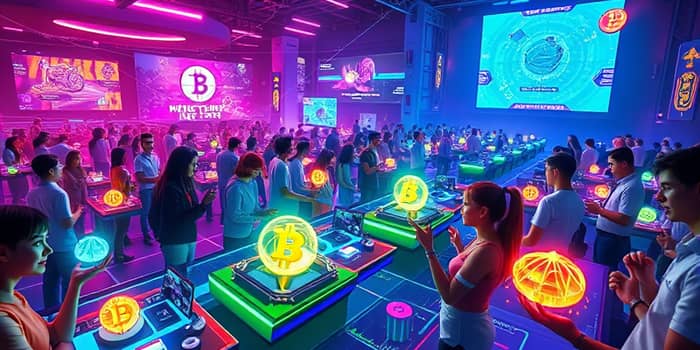At the nexus of immersive entertainment and cutting-edge finance, GameFi emerges as a transformative force. This new paradigm empowers players to monetize their passion while contributing to an open, decentralized digital economy.
Defining the GameFi Revolution
GameFi represents the fusion of gaming and decentralized finance, built on blockchain networks. Players earn valuable rewards—cryptocurrencies or non-fungible tokens (NFTs)—by completing in-game objectives.
Unlike traditional titles where digital items hold no external value, GameFi ensures that in-game assets become true property. Characters, land parcels, and items are tokenized, granting players verifiable ownership that lives beyond a central server.
Key Features and Mechanics
Central to the GameFi ecosystem are several groundbreaking mechanisms:
- Play-to-Earn (P2E): Players receive crypto rewards or unique NFTs for achievements and time invested, creating real-world earning potential.
- Tokenization and NFTs: Digital assets, from weapons to virtual land, are minted as NFTs, enabling trade on open marketplaces and cross-game use.
- DeFi Integrations: Yield farming, staking, and liquidity pools allow participants to earn passive income simply by holding tokens or providing liquidity.
These features converge to form an ecosystem where gameplay, finance, and governance overlap, giving players unprecedented power and flexibility.
Blockchain Infrastructure and Standards
GameFi relies on robust blockchain foundations to deliver security and transparency:
- Major blockchains like Ethereum, Binance Smart Chain, and Solana support smart contract execution and asset minting.
- Token standards such as ERC-20 for fungible tokens and ERC-721/1155 for NFTs ensure compatibility across wallets and marketplaces.
- Decentralized governance models allow token holders to vote on key upgrades and economic parameters.
By following widely adopted standards, GameFi projects achieve cross-platform interoperability and reduce the risk of vendor lock-in.
Economic Landscape: Market Size and Data
GameFi taps into a global gaming population of over 3.3 billion users, transforming idle hours into economic opportunity. Yet, this sector inherits the volatility of DeFi and NFT markets, as evidenced by dramatic swings in total value locked (TVL).
Despite market corrections, pioneering titles like Axie Infinity and The Sandbox demonstrate sustained demand for tokenized gaming assets.
Real-World Use Cases and Success Stories
GameFi titles span multiple genres, each showcasing unique value propositions:
- Collectible card games (e.g., Gods Unchained), where rare cards trade for thousands of dollars.
- Virtual world simulators (e.g., Decentraland, The Sandbox) offering land ownership, development, and rental income.
- Role-playing adventures (e.g., Axie Infinity), driving active economies with vibrant player communities.
In emerging economies, players have leveraged P2E earnings to support families, illustrating the social impact of decentralized gaming.
Benefits for Stakeholders
For players, GameFi offers far more than entertainment—it delivers economic agency. Anyone with an internet connection can participate, leveling the financial playing field across geographies.
Developers gain new monetization avenues beyond upfront sales. Ongoing marketplace fees, token sales, and community-driven governance foster deeper player engagement and recurring revenue streams.
The industry as a whole profits from a more transparent and formalized digital asset market. What was once a niche “gray market” for in-game items is now an open economy secured by cryptography.
Challenges and Considerations
Despite its promise, GameFi faces significant hurdles:
Quality vs. Financialization: Early projects often prioritized tokenomics over gameplay, leading to shallow experiences and high churn.
Sustainability Risks: P2E economics rely on constant user growth and token demand—without these, reward models can collapse.
Security Vulnerabilities: Hacks, smart contract bugs, and phishing attacks have led to multi-million-dollar losses.
Regulatory Uncertainty: Jurisdictions worldwide are still defining how to classify and regulate tokenized games and earnings, raising legal questions about gambling and securities laws.
Looking Ahead: Innovations and Mainstream Adoption
As the GameFi landscape matures, developers are balancing rich gameplay with robust economic models. Enhanced graphics, cross-chain asset portability, and integrated DeFi modules promise to elevate the user experience.
Major publishers are experimenting with blockchain-powered titles, signaling potential mainstream uptake. However, success will depend on delivering both engaging narratives and sustainable token economies.
With clearer regulations on the horizon, the foundation is being laid for a more stable and inclusive digital gaming economy. GameFi stands at the forefront of the Web3 vision—empowering users through decentralized ownership and open financial systems.
Conclusion: Embracing a New Era of Play
GameFi is more than a trend—it’s a fundamental shift in how we perceive value, ownership, and interaction within digital worlds. By bridging the gap between fun and finance, GameFi unlocks endless possibilities for creative expression and economic freedom.
Whether you’re a seasoned crypto enthusiast or a passionate gamer, the rise of GameFi invites you to become both player and stakeholder in a shared, thriving ecosystem. The next great adventure awaits—one where your achievements matter both in-game and in life.
References
- https://koinly.io/crypto-glossary/gamefi/
- https://www.coinbase.com/learn/crypto-glossary/what-is-gamefi
- https://www.cointracker.io/learn/gamefi
- https://hedera.com/learning/gaming/gamefi
- https://chain.link/education-hub/gamefi
- https://cointelegraph.com/learn/articles/gamefi-and-defi
- https://www.rapidinnovation.io/post/decentralized-finance-defi-and-gamefi-pioneering-the-next-wave-of-blockchain-innovation-in-2024
- https://paytechlaw.com/en/glossary/definition-gamefi/










